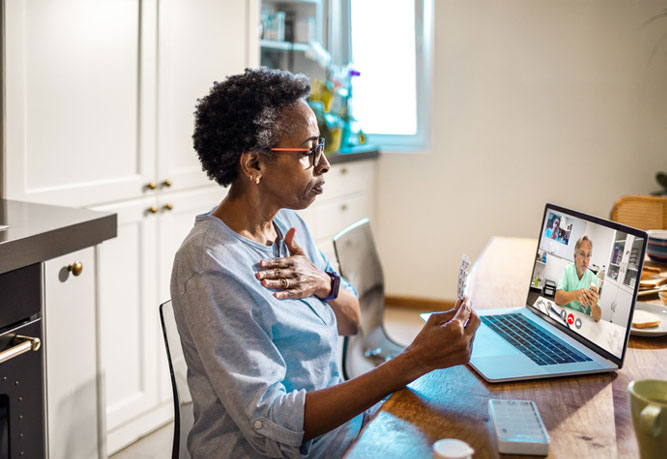Many businesses and industries learned a lot about new ways of operating during the pandemic — in many cases, they would not have previously felt possible, or advisable. The healthcare industry is a prime example. During the pandemic, telehealth has seen a sharp uptick in terms of availability and patient access. It’s likely that this access will continue well into the future.
“The rapid increase in telemedicine has resulted in a number of shifts in employment practices,” says Kate Tulenko, MD. Tulenko is founder and CEO of Corvus Health, a health workforce company, and former director of the US government’s global health workforce program. She is a practicing physician working at four different telemedicine platforms.
Technology—and the pandemic—have driven an increase in interest in ways that patients can be treated without being physically present with their providers.
“High-quality video conferencing, VR technologies, and wider accessibility of simple diagnostic tools allow psychologists, general practitioners, and sometimes even surgeons to consult remotely,” says Inga Shugalo, a healthcare IT analyst at itransition, a software development company. “This can potentially lead to patients being able to choose from a variety of specialists, not limited to the closest area.” It may also mean, she says, “that competition among professionals will become tougher, which should prompt them to increase the quality of healthcare.”
Exploring New Models of Care
Chris Rovin is a partner with Quick.med, a telehealth company, where he oversees several aspects of the business including HR. “We’re hiring doctors from all walks of life,” says Rovin. “Surgeons, primary care providers, addiction specialists—they all appreciate the geographic flexibility, as well as the flexible hours,” he says. “Telemedicine is far from replacing every in-person interaction, but as peripheral health trackers expand their reach and remote labs become more accessible, telemed docs will be able to diagnose and treat more and more remotely.”
Craig Allan Ahrens, VP of growth and development for CareRev, a marketplace technology that connects hospitals and health systems with local healthcare providers, also sees the need for another third type of care. “The next big thing is on-demand care to fill the chasm between telehealth and in-person care,” he says. For example, there may be patients who don’t want to come in to see a provider but need somebody to be with them as they interact with a provider virtually. That might mean a lower level, less expensive provider to come on site with the patient.
This model might mean that the doctor is virtual, but the patient might on occasion see another provider in person. “Some companies are testing this with their employee network, Ahrens says. “In these models, the employee will describe their symptoms, have a follow-up telehealth visit to perform triage, and the telehealth visit determines what type of provider to send to their home to help or if they need to go to the office.”
Benefits and Potential Drawbacks
For physicians, flexibility is one of the big benefits of practicing telemedicine. For patients, access to a much wider range of providers and the convenience of receiving care from home are compelling benefits for exploring telehealth options.
“Physicians who are interested in semi-retirement, who want to travel and work, or set their own hours have been attracted to telemedicine,” says Tulenko. “We have also seen people who want to stay home with young children or take acre of other family members enter telemedicine.”
There are, though, some potential drawbacks related to telemedicine or telehealth, Tulenko says. “With telemedicine there are concerns about patient ‘doctor shopping’ and high rates of unnecessary antibiotic prescriptions,” she says. For patients, she says, there may also be concerns about the lack of continuity of care. “They are at risk of seeing a different caregiver each time they are seen on the telemedicine platform and the provider is not familiar with their history.”
A rise in telehealth and other alternative forms of care delivery will also impact medical schools.
Implications for Education
“Educational institutions are going to have to start training their students how to do telemedicine and providing them clinical opportunities to practice their telemedicine skills,” Tulenko says. There are some distinct differences in both the interview process and the design of the diagnosis process in telemedicine compared to in-person care, she says.
Ahrens agrees. “This evolution of healthcare means that professionals need to be trained differently and that the system needs to be reimbursed differently,” he says. “If a provider does a visit via telehealth, they should be reimbursed for that significantly. Secondly, for at-home care, there should be mechanisms to incentivize people to get paid very well for this and that work be structured in a more on-demand way.”
In addition, says Shugalo, providers will need to be trained in techniques for consulting online to effectively assess patient health, giving self-assessment instructions, building trust via video conference, etc.
They’ll also need to increase their knowledge of at-home health monitoring devices, Rovin says. “The Apple Watch has been huge here, but pulse ox, blood glucose monitoring, and many other biometrics can be tracked at home,” he says.
In addition, medical schools will also likely have to expand the subject matter they cover. What physicians need to be trained on will likely also change to prepare them to practice in a virtual setting, Ahrens says. Customer service training is one example. “Providers will need to become accustomed to a more customer service-focused care model,” he says. In addition to customer service training, he says, “there are the psychosocial training and behavioral health components that come from seeing the person’s home and living conditions and meeting them where they’re at.”
Training for other healthcare staff will also be impacted Shugalo points out. “Healthcare educational institutions will have to include courses and training for technicians and administrators who will be in charge of supporting online sessions, maintaining equipment, etc.”
All these changes, says Shugalo, “will create the demand for more trainers and educators in the industry.”
Another Option, But Not a Replacement
While there are big benefits and new opportunities emerging for providers interested in providing care to patients virtually, Tulenko doesn’t recommend that physicians make telemedicine their entire practice. There is a risk of switching fully to telemedicine,” she says. “It may become difficult to get hired back for in-person because your examination skills may have deteriorated.” In addition, she says, physicians in the US are required to provide the name of other physician references familiar with their work when being licensed or re-licensed. “If you exclusively practice telemedicine, you are at risk of practicing in a vacuum,” she says. “Essentially no one is familiar with your practice.”
Telehealth opens new opportunities for both providers and patients. It’s not likely to replace traditional care though. At least not in the near future.



